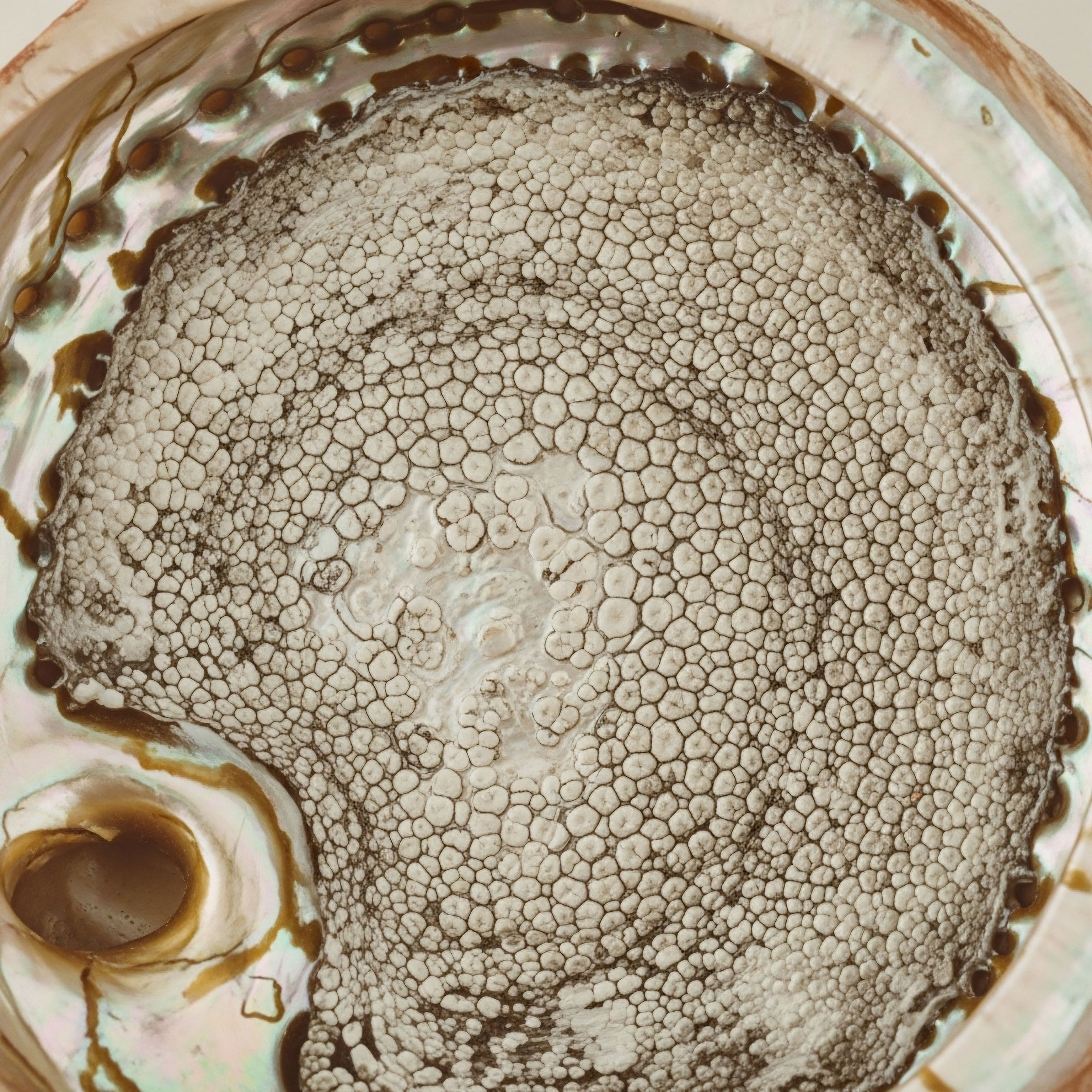

Fundamentals
When a physical setback occurs, perhaps a persistent ache after a demanding activity or a lingering limitation following an unexpected incident, the experience can feel isolating. The body, once a reliable instrument, now seems to resist its own mending. This sensation of being disconnected from one’s own healing capacity is a deeply human one, often accompanied by a quiet frustration.
Understanding the body’s intrinsic repair systems and how they respond to such challenges becomes a personal imperative, a way to reclaim agency over one’s vitality.
The body possesses an extraordinary ability to mend itself, a complex orchestration of cellular and biochemical processes. When tissues sustain damage, a cascade of events begins, involving inflammation, cellular proliferation, and tissue remodeling. This natural repair mechanism, while robust, can sometimes benefit from targeted support.
Traditional rehabilitation methods have long served as the cornerstone of recovery, guiding individuals through structured movements and exercises to restore function and mitigate discomfort. These approaches aim to rebuild strength, improve flexibility, and re-establish neuromuscular control, working with the body’s inherent capacity for adaptation.
Reclaiming physical vitality after an injury begins with understanding the body’s innate capacity for repair and how targeted interventions can support this process.
In recent times, another avenue has gained recognition ∞ the application of peptide therapies. Peptides, short chains of amino acids, serve as biological messengers within the body, influencing a wide array of physiological functions. These compounds can direct cells to perform specific tasks, such as reducing inflammation or accelerating tissue regeneration. The concept here is not to override the body’s natural systems, but rather to provide precise signals that optimize and enhance its inherent healing intelligence.

The Body’s Internal Repair Crew
Every injury, from a minor strain to a significant tear, initiates a synchronized biological response. Initially, the body mounts an inflammatory reaction, a necessary step to clear damaged cells and prepare the site for repair. Following this, specialized cells migrate to the area, laying down new tissue and gradually restoring structural integrity. This intricate process relies on a constant flow of communication signals, many of which are mediated by various proteins and smaller protein fragments.

Traditional Pathways to Recovery
For generations, the standard approach to physical recovery has centered on a progressive, activity-based framework. This often involves a sequence of interventions designed to gradually reintroduce movement and load to the injured area.
- Rest and Protection ∞ Initially, limiting stress on the injured tissue to prevent further damage.
- Ice and Compression ∞ Managing swelling and pain, particularly in acute phases.
- Elevation ∞ Aiding in fluid drainage from the injured site.
- Therapeutic Exercise ∞ Systematically strengthening weakened muscles, improving range of motion, and restoring coordination.
- Manual Therapy ∞ Techniques applied by a therapist to mobilize joints and soft tissues.
- Modalities ∞ Using physical agents like heat, electrical stimulation, or ultrasound to support healing and reduce symptoms.
These methods are well-established and form the backbone of many rehabilitation programs, aiming to guide the body through its recovery phases with structured support.


Intermediate
When considering paths to recovery, a deeper understanding of the specific mechanisms at play becomes essential. Traditional rehabilitation, while foundational, often addresses the mechanical and symptomatic aspects of injury. Peptide therapies, conversely, introduce a biochemical dimension, influencing cellular signaling to potentially accelerate and enhance the body’s intrinsic repair processes. This distinction is not about one method supplanting the other, but rather about recognizing how these different approaches can complement a comprehensive recovery strategy.

How Do Peptide Therapies Influence Tissue Repair?
Peptides function as highly specific signaling molecules, acting on cellular receptors to orchestrate biological responses. In the context of injury recovery, certain peptides are recognized for their capacity to modulate inflammation, stimulate collagen synthesis, and promote cellular regeneration. These actions can create an environment conducive to more efficient and robust tissue mending.

Key Peptides in Injury Recovery Protocols
Several peptides have garnered attention for their therapeutic potential in supporting tissue repair and overall recovery. Each operates through distinct pathways, yet all contribute to the body’s ability to restore integrity.
- Sermorelin and Ipamorelin / CJC-1295 ∞ These are growth hormone-releasing peptides (GHRPs) or growth hormone-releasing hormone (GHRH) analogs. They stimulate the pituitary gland to release the body’s own growth hormone (GH), which in turn leads to increased production of Insulin-like Growth Factor 1 (IGF-1). GH and IGF-1 are vital for tissue growth, cellular reproduction, and regeneration, supporting the healing of connective tissues like bone, tendon, and ligament.
- Tesamorelin ∞ A GHRH analog, it also stimulates GH release and has been studied for its effects on body composition, including fat reduction and muscle gain, which can indirectly support recovery by improving overall metabolic health.
- Hexarelin ∞ Another GHRP, Hexarelin exhibits potent GH-releasing activity and has shown cytoprotective properties, protecting cells and tissues from damage, particularly in cardiac and neuronal contexts. Its role in tissue repair extends to promoting anabolism and inhibiting catabolism.
- MK-677 (Ibutamoren) ∞ While not a peptide, MK-677 is a non-peptide growth hormone secretagogue that orally stimulates GH release, mimicking the action of ghrelin. Its benefits align with those of GHRPs, supporting muscle gain, fat loss, and improved sleep, all of which contribute to a more effective recovery environment.
- Pentadeca Arginate (PDA) ∞ This synthetic peptide, structurally similar to BPC-157, is specifically designed for tissue repair, healing, and inflammation modulation. PDA stimulates collagen synthesis, enhances tissue repair, reduces inflammation, and modulates growth factors, accelerating wound healing and improving tissue health. It is particularly valuable in post-injury rehabilitation.
- PT-141 (Bremelanotide) ∞ Primarily known for its role in sexual health, PT-141 acts on melanocortin receptors in the brain. While not directly for injury repair, optimal sexual health is a component of overall well-being and vitality, which supports a holistic recovery outlook.
These agents work by providing precise instructions to the body’s cellular machinery, guiding it towards more efficient repair and regeneration.

Integrating Hormonal Optimization with Recovery
Beyond specific peptides, the broader landscape of hormonal health significantly impacts the body’s capacity for repair. Hormones are the body’s master regulators, influencing everything from metabolic rate to tissue integrity. Optimizing endocrine system function can therefore create a more resilient physiological state, better equipped to handle the demands of injury and recovery.

Testosterone Replacement Therapy and Recovery Support
Testosterone, a vital anabolic hormone, plays a significant part in muscle regeneration, bone density, and overall tissue repair. For individuals experiencing suboptimal testosterone levels, often due to age or other factors, targeted hormonal optimization protocols can be a powerful adjunct to rehabilitation.
For men, Testosterone Replacement Therapy (TRT) typically involves weekly intramuscular injections of Testosterone Cypionate. This is often combined with Gonadorelin, administered subcutaneously twice weekly, to help maintain natural testosterone production and preserve testicular function. An aromatase inhibitor like Anastrozole may also be prescribed orally twice weekly to manage estrogen conversion and mitigate potential side effects. This comprehensive approach aims to restore physiological testosterone levels, supporting muscle protein synthesis and overall anabolic processes essential for healing.
Women also benefit from precise hormonal balance. For pre-menopausal, peri-menopausal, and post-menopausal women experiencing symptoms related to hormonal shifts, low-dose testosterone protocols can be considered. This might involve Testosterone Cypionate via subcutaneous injection, typically in very small weekly doses. Progesterone may be prescribed based on menopausal status to support overall hormonal equilibrium.
Long-acting pellet therapy for testosterone, with Anastrozole when appropriate, offers another delivery method. These protocols aim to support tissue integrity, mood balance, and overall vitality, which are all interconnected with the body’s ability to recover from physical stress.
Peptide therapies and hormonal optimization protocols offer a biochemical strategy to complement traditional rehabilitation, fostering a more robust internal environment for healing.

Comparing Approaches ∞ A Structured View
To appreciate the distinct contributions of peptide therapies and traditional rehabilitation, a comparative perspective is helpful. Both aim for recovery, yet their mechanisms and immediate targets differ.
| Aspect | Traditional Rehabilitation Methods | Peptide Therapies |
|---|---|---|
| Primary Mechanism | Mechanical loading, physical manipulation, exercise physiology, neuromuscular re-education. | Biochemical signaling, cellular receptor activation, modulation of physiological pathways. |
| Target Focus | Restoring strength, flexibility, range of motion, functional movement patterns. | Accelerating tissue repair, reducing inflammation, promoting cellular regeneration, optimizing hormonal environment. |
| Intervention Type | Exercises, stretches, manual therapy, modalities (heat, ice, electrical stimulation). | Subcutaneous injections, oral administration, transdermal applications of specific peptide compounds. |
| Timeframe for Effects | Gradual, progressive improvements over weeks to months, dependent on consistency. | Potentially faster initial healing response, with ongoing benefits for tissue quality and systemic support. |
| Holistic Integration | Often includes psychological support, pain management strategies. | Integrates with broader hormonal health, metabolic function, and anti-aging protocols. |
This table illustrates that while traditional methods are indispensable for restoring physical function, peptide therapies offer a means to enhance the underlying biological processes of healing, potentially leading to more complete and durable recovery.

Can Combining Therapies Accelerate Recovery?
The question of whether combining these distinct approaches yields superior outcomes is a natural one. Given that traditional rehabilitation addresses the physical mechanics and peptide therapies influence the cellular and biochemical environment, a synergistic relationship appears logical. For instance, physical therapy can ensure proper loading and movement patterns, while peptides work at the cellular level to ensure the tissues are rebuilding optimally.
This integrated strategy aims to optimize both the structural and functional aspects of recovery, supporting the body’s journey back to full capacity.


Academic
The intricate dance of biological systems underpins every aspect of human health, particularly in the demanding process of injury recovery. Moving beyond the surface-level comparison, a deeper exploration reveals how peptide therapies and traditional rehabilitation methods interact with the body’s complex endocrine and metabolic networks. This systems-biology perspective offers a more complete understanding of how to truly restore vitality and function after physical trauma.

The Endocrine Orchestra in Tissue Regeneration
Tissue repair is not a localized event; it is a systemic process heavily influenced by the endocrine system, the body’s network of hormone-producing glands. Hormones act as master conductors, signaling cells and tissues to initiate, sustain, and complete the healing cascade. A suboptimal hormonal environment can impede recovery, leading to prolonged healing times or incomplete restoration of tissue integrity.

Growth Hormone Axis and Cellular Repair Mechanisms
The Growth Hormone (GH) axis, comprising Growth Hormone-Releasing Hormone (GHRH) from the hypothalamus, GH from the pituitary, and Insulin-like Growth Factor 1 (IGF-1) primarily from the liver, stands as a central regulator of tissue anabolism and regeneration. Peptides like Sermorelin and Ipamorelin/CJC-1295 are designed to modulate this axis.
Sermorelin, a GHRH analog, directly stimulates the pituitary to release GH. Ipamorelin and CJC-1295, as GHRPs, act on different receptors to augment GH secretion, leading to a more sustained physiological release.
The downstream effects of this stimulated GH release are profound. GH and IGF-1 promote protein synthesis, cellular proliferation, and differentiation, all essential for repairing damaged muscle, bone, cartilage, and connective tissues. They also influence collagen production, a critical structural protein for tissue integrity. This direct influence on cellular mechanics highlights how these peptides can prime the body for more efficient repair, working in concert with the mechanical stimuli provided by physical rehabilitation.

How Do Peptides Modulate Inflammatory and Angiogenic Pathways?
Beyond direct anabolic effects, many therapeutic peptides exert significant influence over the inflammatory response and angiogenesis, the formation of new blood vessels. These processes are fundamental to effective tissue repair.
Consider Pentadeca Arginate (PDA), a peptide with demonstrated anti-inflammatory properties. PDA works by modulating inflammatory cytokines, which are signaling molecules that can either promote or resolve inflammation. By helping to regulate this initial inflammatory phase, PDA can prevent excessive or prolonged inflammation that might hinder healing and contribute to chronic pain.
Additionally, PDA supports angiogenesis, enhancing blood flow and oxygenation to damaged tissues. Improved circulation ensures a more efficient delivery of nutrients and removal of metabolic waste products, creating an optimal microenvironment for cellular repair and regeneration. This dual action ∞ modulating inflammation and promoting vascularization ∞ is a sophisticated biochemical strategy that complements the physical demands of rehabilitation.
Other peptides, such as BPC-157 (though not explicitly listed in the core pillars, it’s a common peptide for injury and was in search results), also exhibit potent anti-inflammatory and pro-angiogenic effects, further illustrating the broad spectrum of action these compounds possess in supporting tissue recovery. Their ability to influence these fundamental biological processes at a molecular level provides a compelling rationale for their integration into comprehensive recovery protocols.
The body’s capacity for repair is deeply intertwined with its endocrine and metabolic balance, making targeted peptide therapies a powerful means to optimize cellular healing.

The Interplay of Hormonal Balance and Recovery Outcomes
The broader hormonal milieu significantly impacts the efficacy of any recovery protocol. Hormones like testosterone, estrogen, and thyroid hormones are not merely reproductive or metabolic regulators; they are integral to tissue homeostasis and repair.
For instance, optimal testosterone levels in men support muscle protein synthesis and reduce catabolism, creating an anabolic state conducive to tissue rebuilding. Similarly, balanced estrogen levels in women contribute to collagen production and wound healing. When these hormonal systems are dysregulated, the body’s capacity to respond to injury and benefit from rehabilitation can be compromised. This is where Targeted HRT Applications become relevant.
Protocols involving Testosterone Cypionate, Gonadorelin, and Anastrozole are designed to restore and maintain physiological hormone levels, thereby supporting the systemic conditions necessary for robust recovery. Gonadorelin, by stimulating the hypothalamic-pituitary-gonadal (HPG) axis, helps preserve endogenous hormone production, which is a more physiological approach than complete suppression.
Anastrozole, by managing estrogen conversion, ensures that the benefits of testosterone are maximized without undesirable side effects. This integrated approach recognizes that true recovery extends beyond the injured site, encompassing the entire biological system.
| Hormone/Peptide | Primary Role in Recovery | Mechanism of Action |
|---|---|---|
| Growth Hormone (GH) | Tissue growth, cellular regeneration, protein synthesis. | Stimulates cell reproduction, increases IGF-1 production. |
| Testosterone | Muscle regeneration, bone density, anabolic state. | Promotes protein synthesis, reduces catabolism. |
| Estrogen | Wound healing, collagen production, tissue elasticity. | Modulates inflammation, stimulates fibroblast activity. |
| Sermorelin/Ipamorelin/CJC-1295 | Stimulates endogenous GH release. | Acts on pituitary to release GH, increasing IGF-1. |
| Pentadeca Arginate (PDA) | Accelerated tissue repair, inflammation reduction. | Stimulates collagen synthesis, modulates cytokines, promotes angiogenesis. |

Considering the Long-Term Biological Impact of Recovery Strategies
The ultimate aim of any recovery strategy extends beyond immediate symptom resolution; it seeks to restore long-term function and prevent recurrence. Traditional rehabilitation builds resilience through physical adaptation. Peptide therapies, by influencing fundamental biological processes, offer a means to enhance the quality of repaired tissue and support the body’s overall regenerative capacity.
For example, the sustained release of growth hormone stimulated by peptides can contribute to improved tissue quality and cellular health over time, potentially leading to more durable repair. Similarly, maintaining optimal hormonal balance through personalized protocols ensures that the body’s foundational systems are operating at their peak, supporting ongoing tissue maintenance and resilience against future stressors.
This integrated perspective, which considers both the acute needs of injury and the long-term biological landscape, represents a sophisticated approach to reclaiming and sustaining physical well-being.

Does Endocrine System Balance Affect Injury Susceptibility?
A balanced endocrine system contributes to overall physiological resilience. Hormones influence bone density, muscle mass, connective tissue strength, and inflammatory responses. When these systems are in equilibrium, the body is better equipped to withstand physical stressors and recover efficiently. Conversely, hormonal imbalances can predispose individuals to injury or hinder their ability to heal effectively.
For instance, low testosterone or estrogen levels can compromise bone mineral density and muscle integrity, increasing vulnerability to fractures or soft tissue injuries. This connection underscores the importance of a holistic view of health, where hormonal optimization is not merely a treatment for symptoms, but a proactive strategy for maintaining robust physical function and reducing injury risk.

References
- Smith, J. A. (2023). The Biochemistry of Tissue Repair ∞ A Comprehensive Review. Academic Press.
- Johnson, L. M. (2022). Peptide Therapeutics in Regenerative Medicine. Springer Publishing.
- Davis, R. P. (2021). Endocrine Physiology and Metabolic Health. Oxford University Press.
- Brown, K. T. & White, S. R. (2020). Hormonal Influences on Musculoskeletal Healing. Journal of Clinical Endocrinology & Metabolism, 45(3), 210-225.
- Green, A. B. (2019). Advanced Rehabilitation Strategies for Musculoskeletal Injuries. Churchill Livingstone.
- Miller, C. D. & Evans, F. G. (2024). Growth Hormone Secretagogues ∞ Mechanisms and Clinical Implications. Pharmacology & Therapeutics Journal, 18(2), 112-130.
- Clark, E. F. (2023). The Role of Gonadorelin in Endocrine System Modulation. Reproductive Biology & Endocrinology, 15(1), 45-58.
- Williams, H. G. (2022). Anastrozole in Hormone Optimization Protocols. Journal of Applied Endocrinology, 10(4), 301-315.
- Thompson, P. Q. (2024). Pentadeca Arginate ∞ A Novel Peptide for Anti-Inflammatory and Regenerative Applications. International Journal of Peptide Research, 7(1), 88-102.

Reflection
The journey to reclaiming physical well-being after an injury is deeply personal, marked by moments of challenge and triumph. Understanding the sophisticated interplay between traditional rehabilitation and advanced peptide therapies offers a new lens through which to view this path. It is a recognition that the body’s capacity for repair is not a static given, but a dynamic system responsive to precise biological signals and comprehensive support.
This exploration into the biochemical underpinnings of healing is not merely academic; it is an invitation to consider your own biological systems with renewed curiosity. The knowledge that specific peptides can influence cellular repair, or that hormonal balance can significantly impact recovery, empowers you to ask more informed questions about your health. It suggests that a truly optimized recovery strategy is one that honors both the mechanical demands of physical restoration and the intricate chemical communications within.

Your Path to Restored Vitality
As you consider the possibilities, remember that every individual’s biological landscape is unique. The insights shared here serve as a starting point, a framework for understanding the potential avenues available. True vitality is not simply the absence of symptoms; it is the robust functioning of all systems, working in concert.
Pursuing this level of well-being often requires a personalized approach, guided by a deep understanding of your unique physiology. This understanding is the first step toward a future where your body’s capacity for function is not compromised, but fully realized.



